The Battle of the Java Sea in 1942 was a major victory for the Imperial Japanese Navy. The recently published Senshi Sōsho volume 26, The Operations of the Navy in the Dutch East Indies and the Bay of Bengal, contains translated Japanese sources which give insight into Japanese tactics and the Naval Command’s appreciation of the battle. The course of the battle proved to be a rude awakening for the Japanese as it put their whole outranging tactic and torpedo tactic into question.
Dr. W.G.J. Remmelink*
Much has been said and written about the Battle of the Java Sea. For foreign readers, however, a comprehensive account from the Japanese side has been lacking until now. As we all know, the battle was a major victory for the Imperial Japanese Navy. Nevertheless, the official communiqué from Imperial General Headquarters was remarkably terse. The lack of any detail, except for the explicit mention of the length of the battle, shows that the high command of the Navy was non-plussed, if not dismayed, by the length of this almost eight-hour battle. Decisive battles were not supposed to last that long. It is something that also struck Samuel Morison, the first western historian of the battle.[1] ‘That [the battle] lasted so long was,’ in his eyes, ‘due to Admiral Doorman’s stubborn determination and the admirable manner in which men of the three Allied Navies under his command fought and fought until they could fight no more.’
Without taking anything away from the valor and determination of Doorman and his men, we now know that there were other factors that crucially determined the length of this battle. Like all navies in the interbellum years, the Japanese Navy was obsessed with the idea of a decisive battle that would be decided in a matter of minutes because of the great progress made in gun and torpedo fire. This led to a basic naval doctrine that was wedded to big guns and capital ships. But here the Japanese were at a disadvantage. The Washington Naval Treaty of 1922 had capped the relative strength in capital ships between the United States and Japan at a ratio of 5:3, which put the strength of the Japanese Fleet effectively at 60 percent of the American Fleet. The Washington Naval Treaty ratios led to years of bickering within the Japanese Navy with hotter heads demanding at least parity with the Americans and cooler heads maintaining that Japan could never win an arms race against America. In 1936, the hot heads prevailed and Japan stepped out of the Second London Naval Treaty, leaving it free to expand its navy. However, in the four years until the outbreak of the war, it wasted much of its capacity to build two super battleships, which would play no real role during the war.
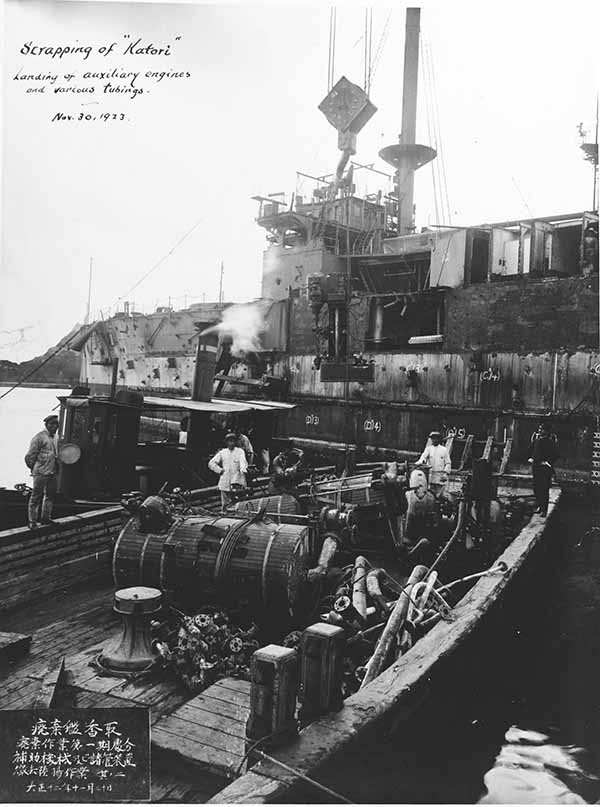
The Japanese battleship Katori, photographed on 30 November 1923 at Maidzuru Navy Yard, while being dismantled under the terms of the Washington Treaty on naval disarmament. Photo US Naval History and Heritage Command
Japanese tactics and naval doctrine
The Japanese did, however, devise a tactic to overcome their inferiority in the number of capital ships. This was the so-called ‘outranging the enemy’ tactic. The idea was to hit the enemy at the outset of a decisive encounter with concentrated long-range shell fire at a distance from which the enemy could not retaliate. In due course, this concept was further applied to the use of torpedoes, submarines, and, of course, naval aircraft.[2] In the case of torpedoes, the Japanese had a truly revolutionary weapon, a pure oxygen torpedo with a maximum range of 40 km, but more typically fired at a 20-km range, which was still double the range of most Allied torpedoes. Moreover, since oxygen is soluble in water, it left practically no visible wake. By 1940, the new torpedo was placed on all cruisers and most destroyers, while at the same time Japanese naval tacticians had also worked out a new torpedo tactic, the long-distance concealed firing tactic.[3] It required the Japanese advance units to fire between 120 to 200 of the new wakeless torpedoes at the enemy battle line from a distance of at least 20 km. The Japanese assumed that most of these torpedoes fired at such a range would go wide of the mark, but if only 10 percent made hits, there would be between twelve and twenty hits on the enemy, throwing him into confusion. This would then be followed by a close-in assault of destroyer squadrons. Rigorous exercises gave the Japanese the confidence that in cruiser-versus-cruiser encounters their torpedoes would be decisive.

The Japanese devised the so-called ‘outranging the enemy’ tactic to overcome their inferiority in the number of capital ships. Photo US Naval History and Heritage Command
How did all this play out in the battle of the Java Sea and did Admiral Doorman and his fleet have somewhat of the chance that Admiral Helfrich thought he had? If Doorman had faced the original escort of the convoy, he would have had a considerable chance, but five days before the battle, Vice Admiral Takahashi, the Japanese commander, started to entertain doubts about the remaining Allied strength and decided to add the 5th Cruiser Division and the 2d Destroyer Squadron to the Java invasion convoy escort and ordered them to be ready by the evening of the 26th. This increased the strength of the escort to two heavy cruisers, two light cruisers and fourteen destroyers against Doorman’s fleet of two heavy cruisers, three light cruisers and nine destroyers. Put in these terms, Doorman had one light cruiser more but five destroyers less than the Japanese. In terms of firepower, however, the Japanese were far superior, especially in terms of torpedoes.[4]
Japanese naval doctrine prescribed that convoys and naval vessels should not proceed until sufficient command of the air had been established. The army, however, pushed to speed up the invasion schedule as much as possible. In the end, the Navy gave in and allowed the convoys to depart even though command of the air had not yet sufficiently been established at the landing areas. As a result, both the western and eastern Java invasion convoys steamed into the Java Sea at a time when the Japanese suspected that the Allies still had some air forces left, and Doorman’s Striking Force was still largely intact.
The Japanese expected that they could cover the convoy and the landing with their land-based air and seaplane units from southern Celebes and southern Borneo. On 27 February, however, inclement weather in these areas grounded virtually all their planes. That did not apply to the remnants of the Allied air force on Java, but there does not seem to have been any coordinated attempt to support Doorman’s Striking Force, apart from a pointless attack by three American dive-bombers together with ten or eleven fighter planes on the few escorting destroyers of the Japanese convoy.[5] These aircraft might have been better employed in a direct attack on the slow-moving ships of the convoy, or even better in support of Doorman’s Striking Force, which had just engaged in battle. But with coordination and communications on the Allied side as they were, even the few reconnaissance messages reached Doorman too late or not at all. As a result, the Battle of the Java Sea on 27 February shaped up as a classic surface-to-surface battle with the only planes in the air the spotter planes of the Japanese cruisers. Why the Allied fleet had not taken along its own spotter planes remains a mystery. Doorman’s own request for fighter-plane cover went unheeded, and thereby the chance was lost to eliminate the Japanese spotter planes who kept trailing him throughout the battle.
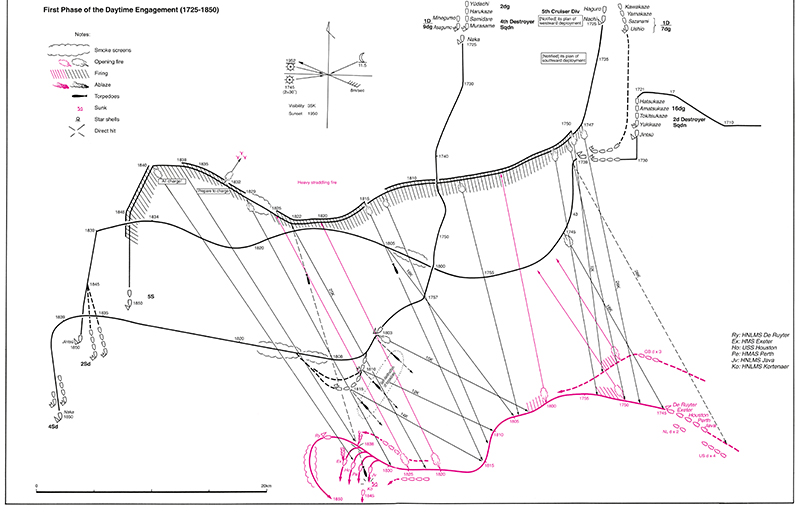
The Sea Engagement off Surabaya [Battle of the Java Sea] 27 February 1942 (daytime engagement, phase 1, Japan Standard Time). Source: based on the action reports of the 5th Cruiser Div, the 2d and the 4th Destroyer Sqdns
The Japanese playbook
Once the opposing fleets had come within sight of each other, the battle developed according to the Japanese playbook. Or as one Japanese commentator described it after the war, ‘The enemy fleet was just like a small bird stalked by a predatory eagle, and its destruction was just a matter of time. The Japanese cruiser division operated in perfect order, just as in the yearly Pacific Ocean exercises….’[6]
Although this is a somewhat over-dramatic description by an officer, who himself had not been present, when we look at the Japanese reconstruction of the first phases of the battle, we see a clear implementation of the Japanese ‘outranging’ tactic. First the concentrated long-range shell fire at distances of more than 20 km. Then the long-range concealed torpedo launches, although in this case the Japanese 4th Destroyer Squadron had opened up earlier at a closer distance. In the first phase of the engagement, which lasted about 50 minutes, the Japanese fleet fired almost 1500 shells[7] and 39 torpedoes. A smaller number of torpedoes than the tactical doctrine prescribed, but that was because the cruiser Nachi had been unable to fire hers because of an alleged malfunction. In fact, it had been a human error. Someone had already opened the main air pressure valve to the torpedo launching tubes. When the order came to open the valve, they could not open it further and reported a malfunction. The torpedoes of the Nachi would, however, play later a major role in the last phase of the battle. Of the 39 torpedoes in the first phase only one hit a target, the Dutch destroyer Kortenaer. Most of the almost 1500 shells fired dropped harmlessly into the sea. Only two hit targets, one hit the Dutch cruiser De Ruyter, but proved a dud and did not explode, the other one, however, hit the British heavy cruiser Exeter in the engine room and caused her to swerve out of line. The Exeter was the second ship in line and unsure what had happened the other ships initially followed her, throwing the Allied battle line into confusion. When Doorman, who was sailing ahead in De Ruyter, noticed the disarray behind him, he made a large left turn, which he was forced to make anyway since the Japanese had gotten ahead of him and were threatening to cross his T, and ordered the Allied ships to follow him.
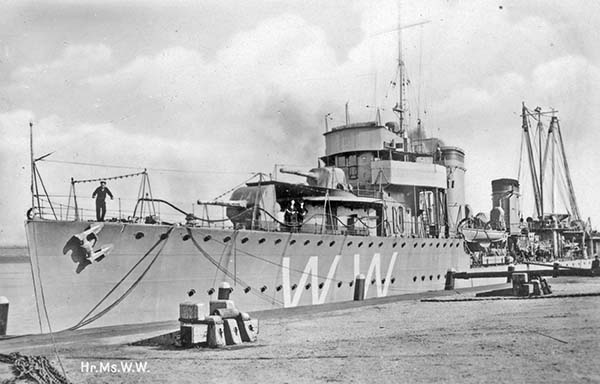
Dutch destroyer Witte de With, which Doorman allowed to escort the British heavy cruiser Exeter to Surabaya. Photo US Naval History and Heritage Command
The Japanese commander on site, Rear Admiral Takagi, naturally thought that this was the moment to deal a decisive blow and gave the ‘all-charge’ order. Meanwhile, the battle site was covered in smoke screens while the Allied fleet first tried to shield the Exeter and then got back in line after Doorman. To relief the pressure, Doorman ordered the three British destroyers to counterattack, an action in which the Electra was lost but not before inflicting heavy damage on the Japanese destroyer Asagumo. He also allowed the Exeter to retire to Surabaya and had her escorted by the Dutch destroyer Witte de With. Having reconstituted his line of battle, Doorman escaped to the southeast while the four American destroyers fired all their torpedoes to no effect at the pursuing Japanese. Afraid of being lured into a minefield, Takagi halted the pursuit and ordered his forces to reassemble while keeping them positioned between the convoy and the Allies.

The Sea Engagement off Surabaya [Battle of the Java Sea] 27 February 1942 (daytime engagement, phase 2, Japan Standard Time). Source: based on the action reports of the 5th Cruiser Div, the 2d and the 4th Destroyer Sqdns
Although we may admire Doorman’s skill in reconstituting his line of battle, he was most certainly unaware of what he had escaped from. During this phase of the battle, the Japanese fired some 800 shells.[8] The somewhat outdated Japanese fire control systems had difficulty in following targets that sailed in and out of smokescreens. But it was not shell fire the Japanese relied upon. During this phase, they fired no less than 98 torpedoes. Together with the 39 torpedoes in the first phase of the daytime battle, they had fired almost 140 torpedoes with no visible results. After the first wave of torpedoes following the ‘all-charge’ order had been fired and nothing had happened, Rear Admiral Takagi had looked at his officers and asked ‘what to do next?’ Since no one had a clear answer, they had simply continued the engagement. Clearly something had gone wrong. What should have been a textbook example of a decisive surface-to-surface battle, moreover, one that had been practiced at the annual exercises, had turned into a flop. Instead of having been wiped of the surface of the sea, Doorman’s fleet was still largely intact. Doorman had lost his main asset, the heavy cruiser Exeter and three destroyers, but with four cruisers and six destroyers his force was not negligible and soon he was reported to be steering a northwesterly course trying to get to the Japanese convoy around the north.
During the battle, the Japanese never found out what had gone wrong with their torpedoes, but it came as a shock that their main weapon and main tactic had not produced the expected results. What if they had not faced Doorman and his somewhat haphazard formation, but the full strength of the American Pacific fleet? As soon as the fleet got back to Japan, the remaining torpedoes were examined and tested. It turned out that overzealous torpedo crews had fiddled with the triggering mechanism of the fuzes. Afraid that they would not go off on impact, they had set them at a somewhat lower level to ensure that they would actuate on impact. As a result, more than a third of the launched torpedoes had self-destructed on the impact of waves once they had left the safety zone. Or as Rear Admiral Ōyagi, a torpedo authority, later remarked: ‘It was a matter of eternal regret that we had provided each vessel with a sensitivity adjuster for the fuzes.’ Luckily for Takagi, not all his torpedoes had been set to a substandard level, and he would soon need them.
Doorman’s decisions
Darkness had fallen and Doorman was rapidly approaching on a northwesterly course. Takagi had not yet reassembled his forces and was actually dead in the water trying to retrieve his five spotter planes. Doorman almost surprised him. Yanking the last plane off the waters, Takagi immediately accelerated to twenty-eight knots and got ready for shelling. However, the 2d Destroyer Division came sailing in between him and Doorman, launching four torpedoes to no effect. Doorman then probably concluded that he would not be able to outflank the Japanese and turned to starboard setting a southerly course towards the coast of Java. On his way there, the four American destroyers retired to Surabaya. Their commander had apparently decided that with all their torpedoes gone, there was not much point in hanging on.
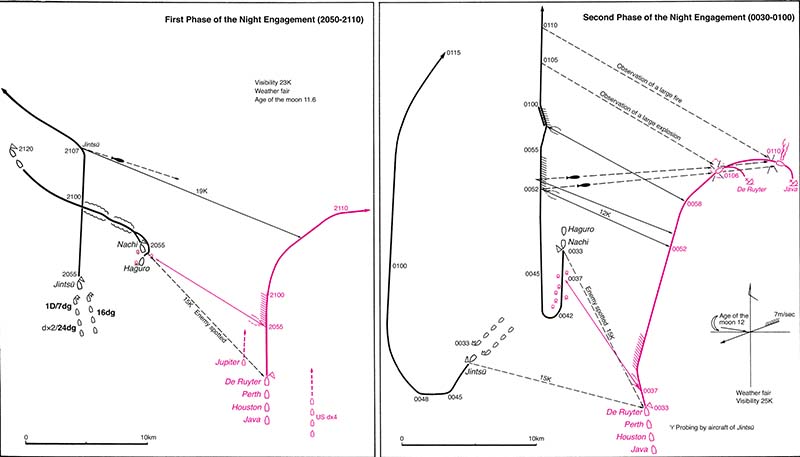
The Sea Engagement off Surabaya [Battle of the Java Sea] 27 February 1942 (night engagement, Japan Standard Time). Doorman’s southerly course along the coast of Java between phase 1 and phase 2 of the night engagement is not depicted. Source: Based on the action reports of the 5th Cruiser Div, the 2d and the 4th Destroyer Sqdns
On reaching the 20-m depth line, Doorman headed west along the coast. On the way, he lost the British destroyer Jupiter who probably ran onto a Dutch mine. What Doorman did not know was that the Japanese had lost him. He was still being followed by a spotter plane from the cruiser Naka, but this plane had lost radio contact with its base. For the first time during the battle, Doorman had eluded the Japanese. A few miles before Cape Awarawar, Doorman headed north again, a course that took him through the site of the daytime battle. When passing the spot where the Kortenaer had sunk, his last remaining destroyer, the British Encounter, was ordered to take the survivors on board and bring them to Surabaya. The remaining four cruisers kept on heading north.
We may wonder why Doorman decided to head north on a course that took him through the daytime battle site. If he had gone further west before heading north, he might have outflanked the Japanese and found the convoy, only protected by a few destroyers. Of course, he did not know where the convoy was and probably assumed that the Japanese knew where he was. Even if he had found the convoy, we may still wonder whether he could have sunk it just with shell fire. The Japanese had found out that it was well-nigh impossible to sink cargo and transport ships with shell fire. Their armored shells would simply fly through the topsides of these ships, punching holes but not exploding. In all cases, they needed torpedoes to finish the job. Doorman’s cruisers, with the possible exception of Perth, did not carry torpedoes.
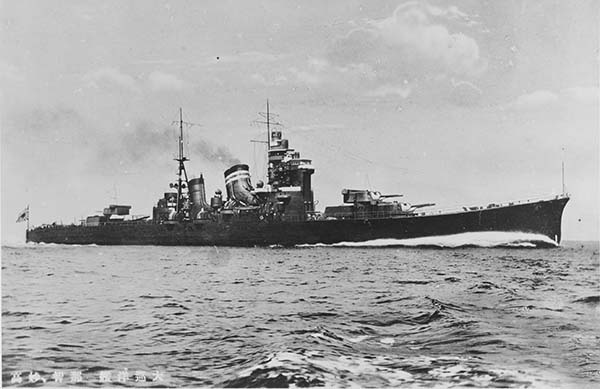
The Japanese heavy cruiser Nachi, which, together with the Haguro, had started sailing south in search of Doorman. Photo US Naval History and Heritage Command
Anyway, the course that Doorman took sent him straight into the Japanese heavy cruisers Nachi and Haguro, who had started sailing south in search of him. Both Japanese cruisers immediately reversed course and on a parallel course a slow gun battle ensued. The Japanese cruisers had started to run out of ammunition. However, they still had torpedoes and this was the chance for the torpedo chief of the Nachi to redeem his honor with the torpedoes that had not been fired during the daytime battle because of a so-called malfunction. The Haguro fired four torpedoes and the Nachi eight, two of which found their marks sinking the Dutch cruisers De Ruyter and Java. It was the end of the battle. Houston and Perth, probably on the orders of Doorman, broke away and took a southwesterly course to Batavia, thereby eluding the Japanese who searched for them in a easterly direction.
For the Japanese, the outcome of the battle was never in doubt. Within one-and-a-half hour after the sinking of the De Ruyter and the Java, Vice Admiral Takahashi arrived on the scene with two more heavy cruisers and two destroyers while also from Bali another cruiser and some destroyers had been summoned. Even if De Ruyter and Java had not been sunk, Doorman would have faced an overwhelming force. The course of the battle, however, was a rude awakening for the Japanese as it put their whole outranging tactic and torpedo tactic into question. Ever since Pearl Harbor they had felt invincible, but a small, ill-assorted Allied Fleet had shown that they were vulnerable after all, and that their main tactical concept was flawed. No wonder that Imperial General Headquarters was not pleased.
Finally, did Doorman have a chance? I am only posing this question because Admiral Helfrich, his commanding officer, thought he had, albeit small. Helfrich did not give any grounds for why he thought that Doorman had a chance and I doubt that he knew enough about the Japanese Navy to make even an educated guess. On paper, as we have seen, Doorman did not stand much of a chance, but battles are not fought on paper, and unpredictable circumstances, such as the inclement weather that grounded the Japanese naval air forces, the Japanese tampering with the fuzes of their torpedoes, and other mistakes, somewhat evened the odds. Much of this, however, was undone by the total lack of Allied air support and reconnaissance.
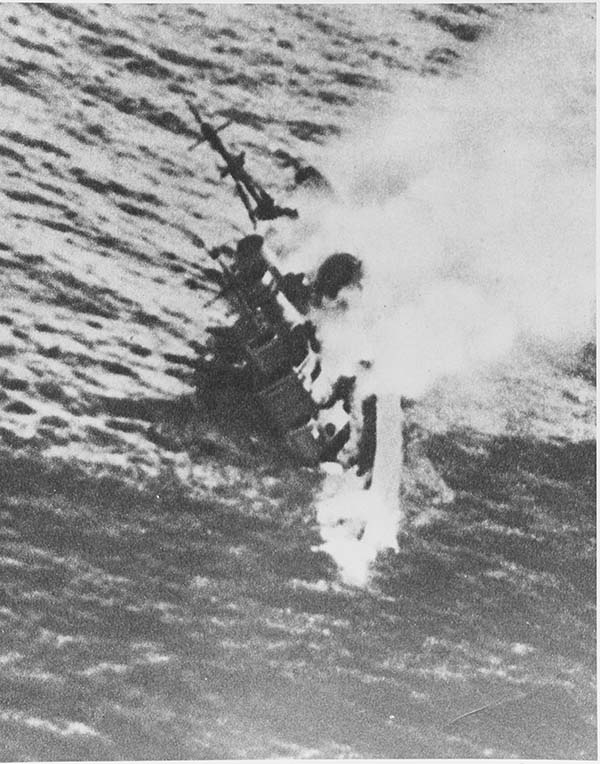
A big blow was the loss of the Exeter, Doorman’s best asset, early in the battle: the ship was sunk the next day (1 March) when she tried to escape after having been provisionally repaired at Surabaya. Photo US Naval History and Heritage Command
A big blow was the loss of the Exeter so early in the battle. She was Doorman’s best asset and without her his fleet lost much of its punch. We may extend this list and even throw in a few ‘what-if’ questions, but I do not think that this is very fruitful. The battle unfolded as it did, and even before the battle Doorman must have realized that despite the odds being stacked against him, it would always be unpredictable. Or as Napoleon used to say, ‘On s’engage et puis on voit’ (You engage and then you see). Doorman and his men engaged with a determination and valor, which one can only admire, and which in my eyes, as a Dutchman, did deserve a little bit more luck.
* Willem Remmelink is a historian and editor/translator of Senshi Sōsho volume 26, The Operations of the Navy in the Dutch East Indies and the Bay of Bengal. The volume was published by the Corts Foundation and can be ordered or downloaded via https://openaccess.leidenuniv.nl/handle/1887/65910. The author presented this paper on 24 September 2018 during the book launch at Leiden University.
[1] Samuel E. Morison, History of United States Naval Operations in World War II, Volume 3, The Rising Sun in the Pacific 1931-1942 (Annapolis, Naval Institute Press, 1948) 358.
[2] For a more detailed discussion, see David C. Evans and Mark R. Peattie, Kaigun. Strategy, Tactics, and Technology in the Imperial Japanese Navy 1887-1941 (Annapolis, Naval Institute Press, 1997) 238-298.
[3] Idem, 266-272.
[4] They mustered twenty 20-cm guns against the Allies’ twelve. In 14-15-cm guns the Allies were slightly superior, but in smaller caliber guns the Japanese far outgunned the Allies. The greatest difference, however, was in the number of torpedo launchers. The Japanese counted 160 61-cm launchers against the Allies’ 79 53-cm launchers.
[5] The Operations of the Navy in the Dutch East Indies and the Bay of Bengal, 436; Ph. M. Bosscher, De Koninklijke Marine in de Tweede Wereldoorlog (Volume 2) 602, note 273.
[6] The Operations of the Navy in the Dutch East Indies and the Bay of Bengal, 453.
[7] In fact, 1,271 20-cm shells and 171 14-cm shells.
[8] In fact, 302 20-cm shells and 15 40-cm shells and 515 12.7-cm shells.